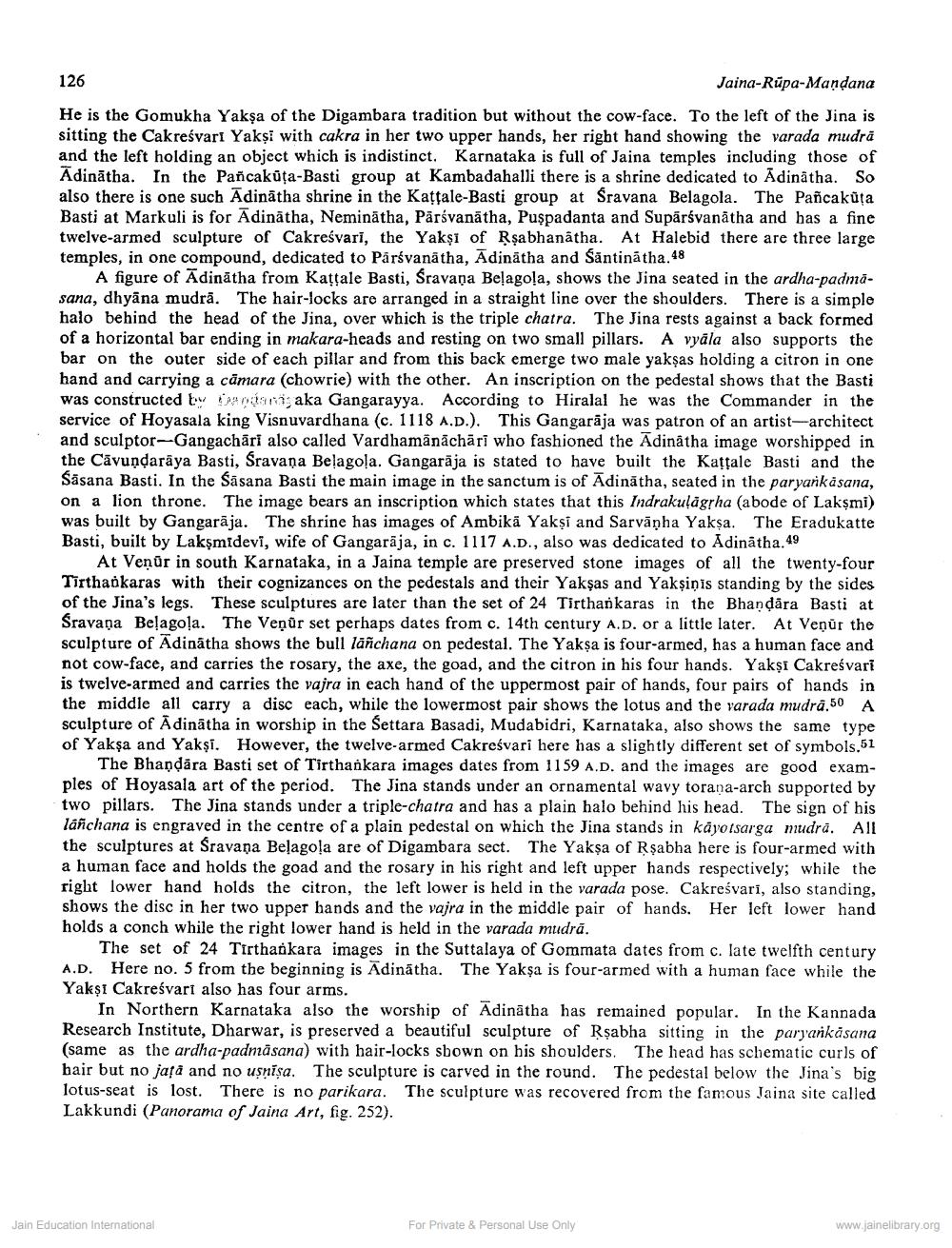________________
126
Jaina-Rupa-Mandana
He is the Gomukha Yakşa of the Digambara tradition but without the cow-face. To the left of the Jina is sitting the Cakreśvarı Yakṣi with cakra in her two upper hands, her right hand showing the varada mudrā and the left holding an object which is indistinct. Karnataka is full of Jaina temples including those of Adinatha. In the Pañcakūta-Basti group at Kambadahalli there is a shrine dedicated to Adinatha. So also there is one such Adinatha shrine in the Kattale-Basti group at Sravana Belagola. The Pañcakūta Basti at Markuli is for Adinatha, Neminatha, Pärśvanatha, Puspadanta and Supärśvanatha and has a fine twelve-armed sculpture of Cakreśvari, the Yakşi of Rṣabhanatha. At Halebid there are three large temples, in one compound, dedicated to Parsvanatha, Adinatha and Santina tha.48
A figure of Adinatha from Kaṭṭale Basti, Śravana Belagola, shows the Jina seated in the ardha-padmasana, dhyāna mudra. The hair-locks are arranged in a straight line over the shoulders. There is a simple halo behind the head of the Jina, over which is the triple chatra. The Jina rests against a back formed of a horizontal bar ending in makara-heads and resting on two small pillars. A vyāla also supports the bar on the outer side of each pillar and from this back emerge two male yakṣas holding a citron in one hand and carrying a camara (chowrie) with the other. An inscription on the pedestal shows that the Basti was constructed by Dandanas aka Gangarayya. According to Hiralal he was the Commander in the service of Hoyasala king Visnuvardhana (c. 1118 A.D.). This Gangaraja was patron of an artist-architect and sculptor-Gangachari also called Vardhamanachārī who fashioned the Adinatha image worshipped in the Cavuṇḍaraya Basti, Sravana Belagola. Gangaraja is stated to have built the Kaṭṭale Basti and the Sasana Basti. In the Sasana Basti the main image in the sanctum is of Adinatha, seated in the paryankasana, on a lion throne. The image bears an inscription which states that this Indrakulāgṛha (abode of Laksmi) was built by Gangaraja. The shrine has images of Ambika Yakşi and Sarvanha Yakṣa. The Eradukatte Basti, built by Lakşmidevi, wife of Gangaraja, in c. 1117 A.D., also was dedicated to Adinatha.49
At Venur in south Karnataka, in a Jaina temple are preserved stone images of all the twenty-four Tirthankaras with their cognizances on the pedestals and their Yaksas and Yakşiņis standing by the sides of the Jina's legs. These sculptures are later than the set of 24 Tirthankaras in the Bhandara Basti at Śravana Belagola. The Venur set perhaps dates from c. 14th century A.D. or a little later. At Venur the sculpture of Adinatha shows the bull läñchana on pedestal. The Yakṣa is four-armed, has a human face and not cow-face, and carries the rosary, the axe, the goad, and the citron in his four hands. Yakşi Cakreśvari is twelve-armed and carries the vajra in each hand of the uppermost pair of hands, four pairs of hands in the middle all carry a disc each, while the lowermost pair shows the lotus and the varada mudrā.50 A sculpture of Adinatha in worship in the Settara Basadi, Mudabidri, Karnataka, also shows the same type of Yakşa and Yakşi. However, the twelve-armed Cakreśvari here has a slightly different set of symbols.51 The Bhandara Basti set of Tirthankara images dates from 1159 A.D. and the images are good examples of Hoyasala art of the period. The Jina stands under an ornamental wavy torana-arch supported by two pillars. The Jina stands under a triple-chatra and has a plain halo behind his head. The sign of his lanchana is engraved in the centre of a plain pedestal on which the Jina stands in kayotsarga mudra. All the sculptures at Sravana Belagola are of Digambara sect. The Yaksa of Rsabha here is four-armed with a human face and holds the goad and the rosary in his right and left upper hands respectively; while the right lower hand holds the citron, the left lower is held in the varada pose. Cakreśvari, also standing, shows the disc in her two upper hands and the vajra in the middle pair of hands. Her left lower hand holds a conch while the right lower hand is held in the varada mudra.
The set of 24 Tirthankara images in the Suttalaya of Gommata dates from c. late twelfth century A.D. Here no. 5 from the beginning is Adinatha. The Yakşa is four-armed with a human face while the Yakşi Cakreśvari also has four arms.
In Northern Karnataka also the worship of Adinatha has remained popular. In the Kannada Research Institute, Dharwar, is preserved a beautiful sculpture of Rsabha sitting in the paryankasana (same as the ardha-padmasana) with hair-locks shown on his shoulders. The head has schematic curls of hair but no jață and no usniṣa. The sculpture is carved in the round. The pedestal below the Jina's big lotus-seat is lost. There is no parikara. The sculpture was recovered from the famous Jaina site called Lakkundi (Panorama of Jaina Art, fig. 252).
Jain Education International
For Private & Personal Use Only
www.jainelibrary.org




